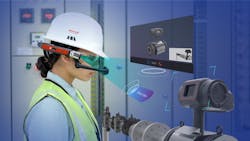In a continuing push to make all plant staff the best plant staff, Honeywell has released hands-free wearable technology that provides industrial workers easy access to live data, documents, work procedures and video, as well as connections to remote experts while they are out in the plant or field.
As part of Honeywell’s Connected Plant suite, Skills Insight Intelligent Wearables respond to voice commands, making it easy for workers to get whatever knowledge they might need to get their tasks completed.
“This new Honeywell Connected Plant technology offers industrial workers the information they need when they need it, wherever they are,” said Youssef Mestari, program director for Honeywell Connected Plant. “That means workers carry with them decades of relevant expertise that is accessible at any time by simple voice activation.”
Honeywell was demonstrating the new technology at the Offshore Technology Conference (OTC) this week in Houston. It uses guided work instructions, for example, to walk field operators through their tasks. “Repetitive tasks can be improved and digitalized and put in step-by-step procedures. Go to pump number 3, check flow, check level, check, check, check, now move on to asset number 2,” Mestari described. “I don’t need to remember everything because it’s guided. I do it faster. I’m not going off script. And I’m doing it very compliant to the standard. That’s how you make everyone operating as the best performer.”
The guided work instructions help reduce the variability that is part of human nature but that can also lead to errors. “We aim to reduce that variability,” Mestari said. “So a worker can operate at the best of his performance and the best of the standards, for every worker all the time.”
Those same step-by-step instructions are what Honeywell uses in Immersive Competency, another wearable technology that the company released at the ARC Industry Forum earlier this year. Geared toward training purposes, it combines mixed-reality technologies with data analytics to create a cloud-based simulation tool.
“A worker can train until he gets it right—in terms of time and in terms of quality,” Mestari said. “Now when he goes out in the field, he’ll do it faster.”
Insights from the Intelligent Wearables can also provide indications that it might be time to revisit the training offered by Immersive Competency.
Say, for example, that a worker has been doing a particular job for six months. The Intelligent Wearables might see a trend in which he’s taking more and more time on step 10 of a given procedure. “This triggers a learning event,” Mestari said, explaining that the worker would have to go back to Immersive Competency to be recertified. “It can see which performer can become the trainer and which needs a refresher. It’s monitoring the exact performance of their job.”
Together, Intelligent Wearables and Immersive Competency create a feedback loop that is the foundation of automation. “This has never been seen before,” Mestari said. “We’re closing the loop on worker performance. I don’t need to train everyone on everything. It’s much more efficient.”
The periodic certification that is common today requires everyone to stop working every two or three years and go through training again. The Skills Insight technologies enable a more productive approach. “Certification will only apply to those who are not complying to standards,” Mestari explained. “Someone could be certified for 10 years in a row without being recertified. That means you’re spending more time in the field.”
For non-repetitive tasks, operators can make use of the Intelligent Wearables to gain access to technical drawings, documents, control data, videos, etc. They can even access remote experts in real time, who can see what the operator sees and offer guidance.
While the Immersive Competency training uses Microsoft’s HoloLens and Windows Mixed Reality headsets, the new Intelligent Wearables technology uses the RealWear HMT-1Z1 hands-free wearable computer, which is certified for Zone 1, Class 1/Div. 1 hazardous locations. The hardware is combined with Honeywell’s Movilizer platform, a cloud-based workflow solution. Key features of the system include:
- Operator task automation: Guided work instruction and procedures plus visualization of documents to facilitate field work.
- Visualization of live data: Real-time Industrial Internet of Things (IIoT) data made available to the field worker.
- Video capture and playback: Learning on demand and on site through playback of video, captured by expert operators working on similar tasks, searchable using voice.
- Expert on call: Instant access to remote experts via video chat, who can see what the field worker sees and can provide advice, share documents or annotate the video feed.
- Geo-localization, navigation and asset visualization: Locates a field operator in the plant and provides navigation and visualization as required for a task.
- Rapid emergency evacuation: Locates workers in the plant and guides them to an assembly point using geo-localization.
- Man-down assistance: Detects a man down, identifying the location and notifying the emergency team for assistance.
The technology addresses two major trends in industrial workforces: a large number of retiring Baby Boomers, and incoming Millennials who are more oriented toward multimedia and multitasking, and expect to be able to get information where they want it and when they want it. The two generations also take different approaches to knowledge consumption. “Our technology is supposed to bridge that gap,” Mestari said.
Leaders relevant to this article:

